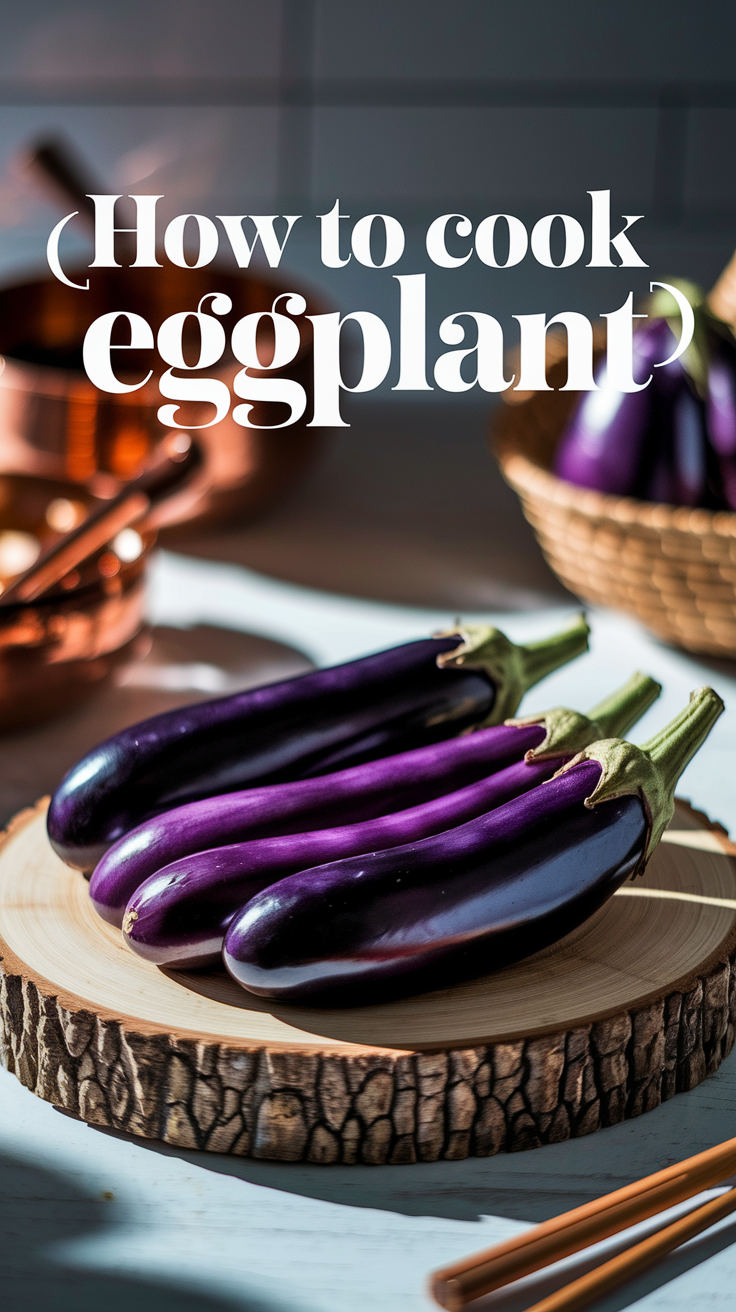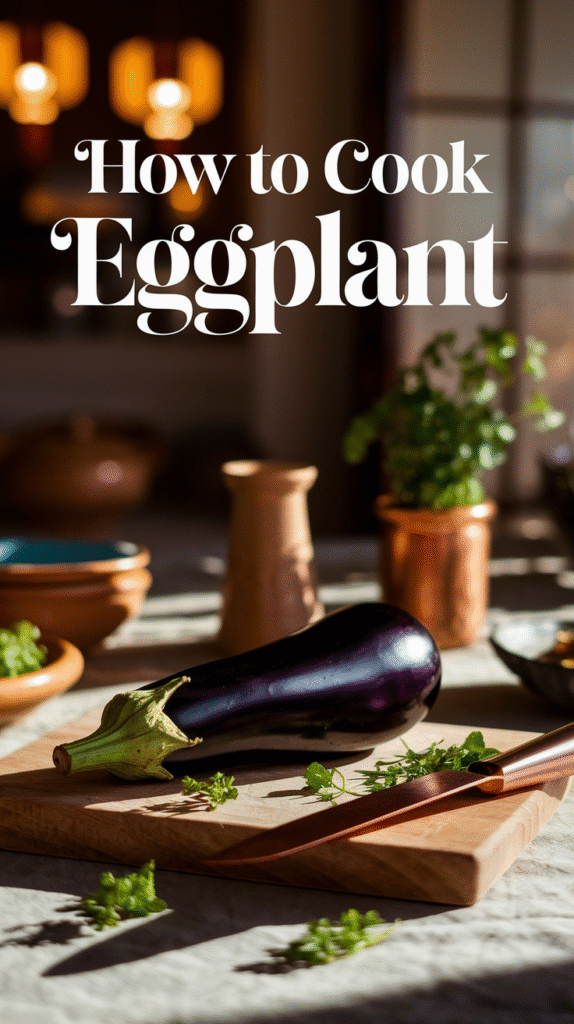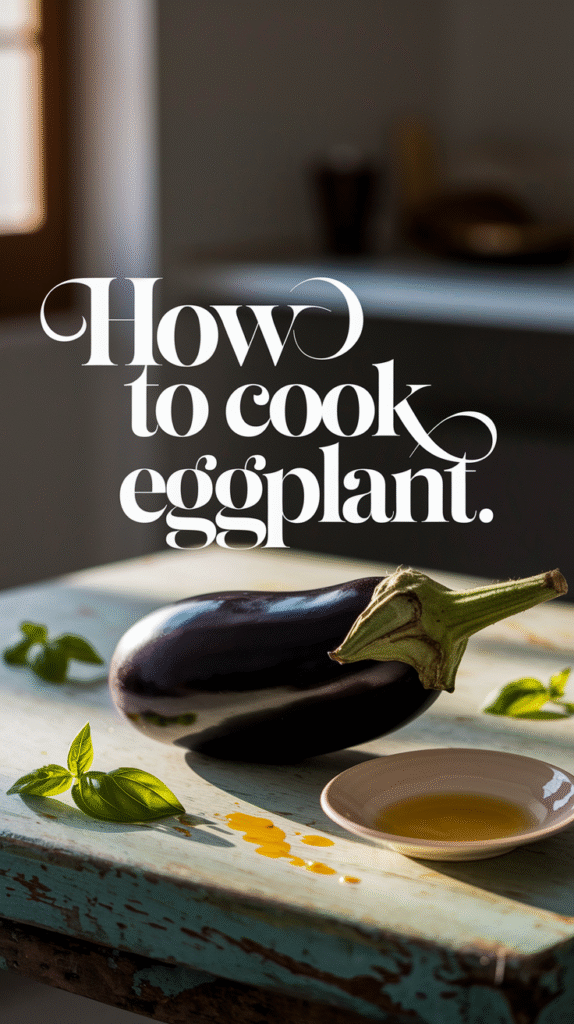Cooking eggplant can seem intimidating, but once you master a few techniques, you’ll find it opens up a world of culinary possibilities. Eggplants, also known as aubergines, are versatile vegetables that absorb flavors beautifully. Here, we’ll explore various methods to prepare this unique ingredient, along with helpful tips for ensuring delicious results every time.
Choosing the Right Eggplant
Before you cook eggplant, it’s crucial to choose the right one. Look for eggplants that are:
- Shiny and firm to the touch.
- Free of blemishes or soft spots.
- Heavy for its size, indicating freshness.
Common varieties include globe eggplant, Japanese eggplant, and Italian eggplant, each with slightly different flavors and textures.
Preparing Eggplant
Once you have selected your eggplant, proper preparation is key. Here are some common techniques:
1. Slicing and Salting
Salting is a traditional method used to remove some of the bitterness from eggplant and to draw out excess moisture. Follow these steps:
- Slice the eggplant into rounds or cubes, depending on your recipe.
- Sprinkle a layer of salt over the slices and let them sit for about 30 minutes.
- Rinse under cold water, then pat dry with a kitchen towel.
This process not only enhances flavor but also helps the eggplant achieve a better texture when cooked.
2. Roasting
Roasting is one of the best ways to bring out the natural sweetness of eggplant. Here’s how to do it:
- Preheat your oven to 400°F (200°C).
- Cut the eggplant into halves or cubes and drizzle with olive oil.
- Season with salt, pepper, and other herbs or spices as desired.
- Spread them evenly on a baking sheet and roast for about 25-30 minutes, or until golden brown and tender.
3. Grilling
Grilling eggplant adds a smoky flavor that’s fantastic in salads or main dishes. To grill eggplant:
- Slice the eggplant into 1/2-inch thick rounds or planks.
- Brush both sides with olive oil and season.
- Preheat your grill to medium-high heat.
- Grill for 4-5 minutes on each side until tender and charred.
4. Sautéing
Sautéing is quick and easy, making it perfect for stir-fries or pasta dishes. Here’s a simple way to sauté eggplant:
- Cube the eggplant and heat olive oil in a large pan over medium heat.
- Add the eggplant and cook, stirring occasionally, for about 10-15 minutes.
- Season with salt and pepper, and feel free to incorporate garlic or onions for added flavor.
Cooking Tips for Eggplant
Keep these tips in mind to ensure your eggplant dishes turn out great:
- Don’t skip salting unless you’re using smaller eggplant.
- Experiment with different spices and marinades to enhance flavor.
- Pair eggplant with ingredients like tomatoes, garlic, and feta cheese for a tasty combination.
- Eggplant absorbs oil easily, so be mindful of the amount of oil used while cooking.
Storing Eggplant
To store eggplants, keep them in a cool, dry place and avoid refrigerating them if possible, as cold temperatures can affect their texture. Ideally, use them within a week of purchasing for the best taste and quality.
Now that you know how to cook eggplant using various techniques, you’re ready to incorporate this nutritious vegetable into your meals. For inspiring recipes and more details on eggplant cooking techniques, consider visiting Serious Eats or Bon Appétit.
Eggplant is a versatile and healthy ingredient just waiting for you to unlock its potential. Happy cooking!
The Nutritional Benefits of Including Eggplant in Your Diet
Eggplant, also known as aubergine, is a versatile vegetable that can add a delightful taste and a splash of color to your meals. But beyond its culinary uses, eggplant is packed with nutritional benefits that can contribute significantly to a healthy diet. Let’s explore some of the reasons why you should consider including it in your meals.
Rich in Nutrients
Eggplant is low in calories yet rich in important nutrients. A one-cup serving of cooked eggplant contains:
| Nutrient | Amount |
|---|---|
| Calories | 35 |
| Fiber | 8 grams |
| Carbohydrates | 9 grams |
| Protein | 1 gram |
| Fat | 0.2 grams |
| Vitamin K | 4% DV |
| Folate | 3% DV |
With this impressive nutrient profile, eggplant is an excellent addition to your diet.
High in Antioxidants
One of the standout features of eggplant is its high antioxidant content. Eggplants contain compounds like nasunin, which is particularly beneficial for brain health. Antioxidants help fight free radicals in the body, potentially reducing the risk of chronic diseases.
Supports Heart Health
Including eggplant in your diet may also promote heart health. The vegetable is rich in fiber, which is known to lower cholesterol levels. Additionally, it contains potassium, which can help regulate blood pressure. Eating eggplant can assist in maintaining a healthy heart and reducing the risk of heart disease.
Helps with Weight Management
If you’re looking to manage your weight, eggplant can be a great ally. Its high fiber content aids digestion and provides a feeling of fullness, which reduces the chances of overeating. Eating low-calorie, high-fiber foods like eggplant can help you stick to your dietary goals.
Promotes Digestive Health
The fiber in eggplant not only helps you feel satiated but also promotes digestive health. Fiber aids in regular bowel movements and prevents constipation. Including eggplant in your meals can support a healthy gut and keep your digestive system functioning smoothly.
Versatile Cooking Options
In addition to its nutritional benefits, eggplant is incredibly versatile in the kitchen. Here are several delicious ways you can prepare and enjoy it:
- Grilled: Slice eggplant and toss it on the grill with some olive oil for a smoky flavor.
- Roasted: Roast eggplant cubes with garlic and herbs for a tasty side dish.
- Stuffed: Hollow out an eggplant and fill it with grains, vegetables, and spices for a hearty meal.
- In Stews: Add eggplant to your favorite stew for an added layer of flavor and nutrition.
Each method retains the vegetable’s unique taste while maximizing its health benefits.
Eggplant into Your Diet
As you consider adding eggplant to your meals, remember to select fresh, firm vegetables that have smooth skin. You can easily include eggplant in a variety of dishes, from Mediterranean to Asian cuisines. If you’re interested in more recipes and ideas, visit EatingWell for inspiration.
Whether you’re looking for a nutritious addition to your meals or a fun ingredient to experiment with in the kitchen, eggplant has something to offer you. By incorporating this nutrient-rich vegetable into your diet, you can enjoy a host of health benefits while savoring the unique flavors it provides.
Exploring Various Eggplant Recipes from Around the World
Eggplant, also known as aubergine, is a versatile vegetable that finds its way into countless recipes worldwide. Its unique texture and ability to absorb flavors make it a staple ingredient in many cuisines. Let’s explore some delightful eggplant recipes from around the globe.
Middle Eastern Delights
The Middle East offers a variety of eggplant dishes that are rich in flavor and history. One of the most famous is Baba Ganoush. This creamy dip is made by roasting eggplants until tender, then blending them with tahini, garlic, lemon juice, and olive oil. Serve it with pita bread for a perfect appetizer.
Another favorite is Imam Bayıldı, a Turkish dish featuring whole eggplants stuffed with a mixture of onions, tomatoes, and spices. This dish is traditionally served cold, making it a refreshing option on hot days.
Italian Inspirations
In Italian cuisine, eggplant is often used in classics like Eggplant Parmesan (Melanzane alla Parmigiana). This dish involves layering slices of fried eggplant with marinara sauce and cheese, then baking until bubbly and golden. It’s a hearty dish that many enjoy with a side of pasta.
Ratatouille, a beloved Provençal vegetable stew, also highlights eggplant. Combining it with zucchini, bell peppers, and fresh herbs creates a colorful and flavorful medley perfect as a side dish or a main meal.
Asian Adventures
Asian cuisines showcase eggplant in a myriad of ways. In Chinese cooking, you might find eggplant stir-fried with garlic and spicy Sichuan sauce. This preparation highlights the vegetable’s ability to soak up bold flavors.
In Japanese cuisine, a popular dish is Nasu Dengaku, where eggplant is grilled and slathered with sweet miso paste. The combination of smoky and sweet creates a delicious flavor that pairs well with rice.
Indian Specialties
Eggplant is a key ingredient in many Indian recipes, notably Baingan Bharta. This dish features roasted eggplant mixed with spices, tomatoes, and onions, resulting in a smoky, flavorful blend that’s great with naan or steamed rice.
Another Indian favorite is Baingan Masala, where eggplant is cooked with a variety of spices, making it a hearty addition to any meal. The spices elevate the eggplant’s natural flavor, creating a dish that warms the soul.
Modern Twists
Modern chefs are getting creative with eggplant too! You might encounter eggplant “steaks” that are marinated and grilled, offering a vegetarian alternative to traditional barbecue options. Another trend includes eggplant pizzas, where thin slices serve as a gluten-free crust topped with your favorite ingredients.
How to Choose and Prepare Eggplant
When selecting eggplants, look for ones that are firm and glossy, without blemishes. Smaller eggplants are often sweeter and less bitter than larger ones. Before cooking, it’s recommended to slice and salt them, letting them sit for about 30 minutes to draw out excess moisture and bitterness.
Helpful Tips for Cooking with Eggplant
- Roasting enhances flavor: Roasting eggplant in the oven gives it a deep, rich flavor.
- Grilling adds a smoky touch: Grilled eggplant develops a unique smokiness that complements many dishes.
- Experiment with spices: Eggplant can take on bold flavors, so don’t hesitate to use spices generously.
Final Thoughts
Whether you’re exploring traditional methods or trying out modern interpretations, eggplant is a wonderful ingredient. Its versatility and ability to absorb flavors make it a favorite among chefs and home cooks alike.
For more incredible eggplant recipes, visit Food Network or check out Serious Eats for valuable cooking tips and inspiration!
Common Mistakes to Avoid When Cooking Eggplant
When it comes to cooking eggplant, many home chefs encounter common pitfalls that can affect the taste and texture of this versatile vegetable. Here, we will explore the mistakes to avoid, helping you create delicious eggplant dishes that shine.
Avoid Skipping Salting
One of the most frequent mistakes is skipping the salting process. Salting draws out excess moisture from the eggplant, which can help reduce bitterness and improve texture. To do this, simply slice your eggplant and sprinkle both sides with salt. Allow it to sit for about 30 minutes, then rinse and pat dry. This step will enhance the flavor and prevent the eggplant from becoming soggy during cooking.
Ignoring the Type of Eggplant
Not all eggplants are created equal. There are many varieties, including globe, Italian, Chinese, and Japanese. Each type has its unique flavor and texture, making them suitable for different cooking methods. For instance:
- Globe Eggplant: This is the most common variety, perfect for grilling or baking.
- Japanese Eggplant: Known for its tender skin and mild flavor, it works well in stir-fries.
- Chinese Eggplant: With its long, slender shape, it’s ideal for braising and steaming.
Neglecting Proper Cooking Techniques
Another mistake is not using the right cooking method. Eggplant can become exceptionally creamy and delicious when roasted or grilled, while frying can make it oily and unappetizing. Here are some effective cooking techniques to consider:
- Roasting: Cut the eggplant into cubes, toss with olive oil, season, and roast at 400°F (200°C) for 25-30 minutes, until golden brown.
- Grilling: Slice the eggplant into thick rounds, brush with oil, and grill until charred and tender.
- Sautéing: Cube the eggplant and cook it in a hot pan with a bit of oil for a quick dish.
Not Pairing with the Right Flavors
Eggplant has the unique ability to absorb flavors, but not pairing it with the right ingredients can lead to disappointing results. Consider enhancing eggplant with:
- Herbs: Basil, oregano, and thyme complement eggplant beautifully.
- Spices: Cumin, paprika, and chili powder can elevate the dish.
- Acids: A splash of balsamic vinegar or a squeeze of lemon can brighten up the flavors.
Overcooking the Eggplant
Overcooking eggplant can turn it mushy and unappealing. When cooked correctly, eggplant should be tender yet still hold its shape. Keep an eye on your cooking time, especially if you are grilling or roasting, as this can happen quickly.
Failing to Choose Fresh Eggplants
Choosing old or under ripe eggplant can affect your dish. Look for eggplants that have smooth, shiny skin and feel heavy for their size. Avoid those with brown spots, wrinkles, or soft spots. Fresh eggplants will have a mild flavor and pleasant texture.
Not Experimenting with Different Dishes
Many people primarily use eggplant in specific dishes, often overlooking its versatility. Think beyond the traditional eggplant Parmesan. Try incorporating eggplant into:
- Stir-fries,
- Curries,
- Ratatouille,
- Stuffed eggplant,
- Pasta sauces, and more!
By avoiding these common mistakes, you can unlock the full potential of eggplant in your cooking. Embrace this flavorful vegetable, and don’t hesitate to experiment with new recipes and cuisines. For additional recipes and eggplant cooking tips, check out Bon Appétit or get inspired by Food Network.
With these insights, you are now ready to tackle any eggplant recipe with confidence. Enjoy your culinary journey with this delectable vegetable!
Creative Ways to Incorporate Eggplant into Everyday Meals
Eggplant, also known as aubergine, is a versatile vegetable that can elevate many everyday meals. With its unique texture and ability to absorb flavors, incorporating eggplant into your dishes can add nutrition and creativity. Here are several creative ways to enjoy this wonderful vegetable in your cooking.
Stuffed Eggplant
One of the best ways to incorporate eggplant into meals is by stuffing it. You can halve the eggplant, scoop out the insides, and use that flesh combined with other ingredients to create a delicious filling. Here are some ideas:
- Quinoa and Veggies: Mix cooked quinoa with sautéed onions, garlic, bell peppers, and spices. Add cheese on top before baking.
- Meat Filling: Ground meat mixed with herbs, spices, and the scooped-out eggplant flesh makes for a hearty meal.
- Rice and Beans: Combine cooked rice, black beans, corn, and spices for a flavorful vegetarian option.
Eggplant Parmesan
This classic Italian dish showcases eggplant beautifully. By slicing the eggplant into rounds, breading, and frying them, you can layer them with marinara sauce and mozzarella cheese. Bake the dish until bubbly and golden. This meal can easily become a crowd-pleaser.
Grilled Eggplant Slices
Grilling eggplant slices brings out their natural sweetness and adds a lovely smoky flavor. Simply brush the slices with olive oil, sprinkle with salt and pepper, and grill until tender. Serve them as a side dish or add them to sandwiches and salads for an extra dimension of flavor.
Eggplant in Curries
Eggplants work wonderfully in a variety of curry recipes. They absorb spices beautifully, complementing the overall dish. Try adding diced eggplant to:
- Chickpea Curry: Mix chickpeas, tomatoes, and spices with chunks of eggplant for a protein-packed meal.
- Coconut Curry: Cook eggplant in a creamy coconut sauce with your favorite veggies for a rich and satisfying dish.
Pasta with Eggplant
Add sautéed or roasted eggplant to your pasta dishes for a healthy twist. It pairs well with tomato sauce, garlic, and fresh basil. You can also blend it into a creamy eggplant sauce with olive oil and lemon juice, perfect for drizzling over any pasta.
Eggplant Dip
Create a tasty dip called baba ghanoush by grilling the eggplant until soft, then blending it with tahini, garlic, lemon juice, and olive oil. Serve it with pita chips or fresh vegetables for a healthy snack or appetizer.
Ratatouille
This classic French dish beautifully showcases the flavors of summer vegetables, including eggplant. Sauté eggplant with zucchini, bell peppers, tomatoes, and herbs for a vibrant and healthy dish that can be served warm or cold. Ratatouille pairs perfectly with crusty bread or over rice.
Eggplant in Salads
Grilled or roasted eggplant makes a lovely addition to salads. Toss it with spinach, feta cheese, walnuts, and a balsamic vinaigrette for a refreshing dish. Eggplant adds a hearty texture, making salads more filling.
Recipes to Get You Started
By exploring these creative ways to incorporate eggplant into your meals, you can enhance your cooking repertoire. Embrace the versatility of this vegetable, and you’ll find that it not only adds flavor but also contributes essential nutrients to your diet. Experimenting with various preparations can lead to delicious discoveries that might end up being your new favorite dishes.
Conclusion
Cooking eggplant opens up a world of culinary possibilities that can elevate your meals and provide numerous health benefits. By mastering various techniques and tips, you can transform this versatile vegetable into a delicious centerpiece or a nutritious side dish. Its rich flavor and unique texture allow it to soak up seasonings, making it an excellent addition to your cooking repertoire.
Moreover, understanding the nutritional benefits of eggplant can encourage you to include it more often in your diet. This vegetable is low in calories yet rich in fiber, vitamins, and antioxidants, offering a healthy boost to your meals. Exploring delicious eggplant recipes from various cultures can also inspire you to get creative in the kitchen, whether it’s a traditional Mediterranean dish or a spicy Asian stir-fry.
However, it’s essential to be aware of common mistakes when cooking eggplant, such as not salting it properly or cooking at the wrong temperature. By avoiding these pitfalls, you can enhance the flavor and texture of your dishes. consider the many creative ways to incorporate eggplant into your everyday meals. From eggplant burgers to flavorful dips, the options are endless.
By embracing eggplant and experimenting with different recipes and cooking methods, you’ll discover a new appreciation for this nutritious vegetable. With practice and curiosity, your culinary journey with eggplant will not only excite your taste buds but also contribute to your overall health. Consider adding eggplant to your next meal and see how it can enrich your dining experience.







Leave a Reply